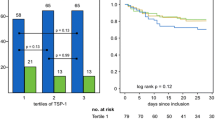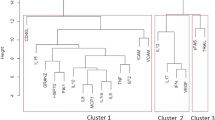Abstract
Interleukin-10 is a potent macrophage-deactivating cytokine that inhibits lipopolysaccharide-induced tumor necrosis factor production. We determined the plasma levels of immunoreactive interleukin-10 in 16 patients with septic shock and in 11 patients with circulatory shock of nonseptic origin. In septic shock, interleukin-10 levels peaked during the first 24 h (median: 48 pg/ml) and decreased progressively till Day 5. In nonseptic shock, interleukin-10 plasma levels also increased during the first 24 h but to a lesser extent (median: 17 pg/ml). In septic shock patients, interleukin-10 plasma levels were positively correlated with tumor necrosis factor (r=0.8,p=0.01) and with parameters of shock severity including lactate levels (r=0.56, p<0.05) and correlated negatively with blood platelet counts (r=−0.65,p<0.05). The decreased production of tumor necrosis factor-α and interleukin-6 afterin vitro incubation of whole blood from septic shock patients with lipopolysaccharide was not influenced byin vitro neutralization of interleukin-10. We conclude that interleukin-10 is produced in patients with circulatory shock of septic and nonseptic origin and that the production of this anti-inflammatory cytokine during septic shock correlates positively with the intensity of the inflammatory response.
Similar content being viewed by others
References
Glauser MP, Heumann D, Baumgartner JD, Cohen J: Pathogenesis and potential strategies for prevention and treatment of septic shock: an update. Clin Infect Dis 18 (suppl 2):S205–216, 1994
Beutler B, Milsark IW, Cerami AC: Passive immunisation against cachectin/tumor necrosis factor protects mice from lethal effect of endotoxin. Science 229:869–871, 1985
Tracey KJ, Fong Y, Hesse DG, Manogue KR, Lee AT, Kuo GC, Lowry SF, Cerami A: Anti-cachectin/TNF monoclonal antibodies prevent septic shock during lethal bacteriaemia. Nature 330:662–664, 1987
Mathison JC, Wolfson E, Ulevitch RJ: Participation of tumor necrosis factor in the mediation of gram-negative bacterial lipopolysaccharide-induced injury in rabbits. J Clin Invest 81:1925–1937, 1988
Fiorentino DF, Zlotnik A, Mosmann TR, Howard M, O'Garra A: IL-10 inhibits cytokine production by activated macrophages. J Immunol 147:3815–3822, 1991
Bogdan C, Vodovotz Y, Nathan C: Macrophage deactivation by interleukin 10: J Exp Med 174:1549–1555, 1991
de Waal Malefyt R, Abrams J, Bennett B, Figdor CG, de Vries JE: Interleukin-10 (IL-10) inhibits cytokine synthesis by human monocytes: an autoregulatory role of IL-10 produced by monocytes. J Exp Med 174:1209–1220, 1991
Gérard C, Bruyns C, Marchant A, Abramowicz D, Vandenabeele P, Delvaux A, Fiers W, Goldman M, Velu T: Interleukin-10 reduces the release of tumor necrosis factor and prevents lethality in experimental endotoxemia. J Exp Med 177:547–550, 1993
Howard M, Muchamuel T, Andrade S, Menon S: Interleukin 10 protects mice from lethal endotoxemia. J Exp Med 177:1205–1208, 1993
Durez P, Abramowicz D, Gérard C, Van Mechelen M, Amraoui Z, Dubois C, Leo O, Velu T, Goldman M: In vivo induction of Interleukin-10 by anti-CD3 monoclonal antibody or bacterial lipopolysaccharide: differential modulation by cyclosporin A. J Exp Med 177:551–555, 1993
Marchant A, Bruyns C, Vandenabeele P, Ducarme M, Gérard C, Delvaux A, De Groote D, Abramowicz D, Velu T, Goldman M: Interleukin-10 controls interferon-γ and tumor necrosis factor production during experimental endotoxemia. Eur J Immunol 24:1167–1171, 1994
Marchant A, Devière J, Byl B, De Groote D, Vincent JL, Goldman M: Interleukin-10 production during septicaemia. Lancet 343:707–708, 1994
De Groote D, Marchant A, Fauchet F, Jadoul M, Dehart I, Gérard C, Gevaert Y, Lopez M, Gathy R, Franssen JD, Radoux D, Franchimont P: Characterisation of monoclonal antibodies against human interleukin-10 and their use in an ELISA for the measurement of this cytokine. J Immunol Meth 177:225–234, 1994
Pradier O, Gérard C, Delvaux A, Lybin M, Abramowicz D, Capel P, Velu T, Goldman M: Interleukin-10 inhibits the induction of monocyte procoagulant activity by bacterial lipopolysaccharide. Eur J Immunol 23:2700–2703, 1993
Pinsky MR, Vincent JL, Devière J, Alegre ML, Kahn RJ, Dupont E: Serum cytokine levels in human septic shock. Relation to multiple-system organ failure and mortality. Chest 103:565–575, 1993
Damas P, Ledoux D, Nys M, Vrindts Y, De Groote D, Franchimont P, Lamy M: Cytokine serum level during severe sepsis in human: IL-6 as a marker of severity. Ann Surg 215:356–362, 1992
Calandra T, Gerain J, Heumann D, Baumgartner JD, Glauser MP: High circulating levels of interleukin-6 in patients with septic shock: evolution during sepsis, prognostic value, and interplay with other cytokines. Am J Med 91:23–29, 1991
van der Poll T, Marchant A, Berman L, Lazarus DD, Keogh CV, Nguyen L, Goldman M, Moldawer LL, Lowry SF: Endogenous interleukin-10 protects against death in septic peritonitis in mice. Surg Forum (in press)
Wanidwonarum C, Strober W: Predominant role of tumor necrosis factor-alpha in human monocyte IL-10 synthesis: J Immunol 151:6853–6861, 1993
van der Poll T, Jansen J, Levi M, ten Cate H, ten Cate JW, van Deventer SJH: Regulation of Interleukin 10 release by tumor necrosis factor in humans and chimpanzees. J Exp Med 180:1985–1988, 1994
Munoz C, Carlet J, Fitting C, Misset B, Bleriot JP, Cavaillon JM: Dysregulation of in vitro cytokine production by monocytes during sepsis. J Clin Invest 88:1747–1754, 1991
Ertel W, Jarrar D, Jochum M, Thiele V, Kenney J, Faist E, Schildberg FW: Enhanced release of elastase is not concomitant with increased secretion of granulocyte-activating cytokines in whole blood from patients with sepsis. Arch Surg 129:90–98, 1994
Setrakian JC, Yee J, Christou NV: Reduced tumor necrosis factor a production in lipopolysaccharide-treated whole blood from patients in the intensive care unit. Arch Surg 129:187–192, 1994
Moore KW, O'Garra A, de Waal Malefyt R, Vieira P, Mosmann TR: Interleukin-10. Ann Rev Immunol 11:165–190, 1993
Ayala A, Deol ZK, Lehman DL, Herdon CD, Chaudry IH: Polymicrobial sepsis but not low-dose endotoxin infusion causes decreased splenocyte IL-2/IFN-g release while increasing IL-4/IL-10 production. J Surg Res 56:579–585, 1994
Zuckerman SH, Evans GF, Snyder YM, Roeder WD: Endotoxinmacrophage interaction: post-translational regulation of tumor necrosis factor expression. J Immunol 143:1223–1227, 1989
Mathison JC, Virca GD, Wolfson E, Tobias PS, Glaser K, Ulevitch RJ: Adaptation to bacterial lipopolysaccharide controls lipopolysaccharide-induced tumor necrosis factor production in rabbit macrophages. J Clin Invest 85:1108–1118, 1990
Ziegler-Heitbrock HWL, Wedel A, Schraut W, Ströbel M, Wendelgass P, Sternsdorf T, Baüerle PA, Haas JG, Riethmüller G: Tolerance to lipopolysaccharide involves mobilization of nuclear factor kB with predominance of p50 homodimers. J Biol Chem 269:17001–17004, 1994
Stefanova I, Corcoran ML, Horak EM, Wahl LM, Bolen JB, Horak ID: Lipopolysaccharide induces activation of CD14-associated protein tyrosine kinase p53/56lyn*. J Biol Chem 268:20725–20728, 1993
Geng Y, Gulbins E, Altman A, Lotz M: Monocyte deactivation by interleukin 10 via inhibition of tyrosine kinase activity and the Ras signaling pathway. Proc Natl Acad Sci USA 91:8602–8606, 1994
Beutler B, Grau GE: Tumor necrosis factor in the pathogenesis of infectious diseases. Crit Care Med 21:S423-S435, 1993
Rabinovici R, John R, Esser KM, Vernick J, Feuerstein G: Serum tumor necrosis factor-alpha profile in trauma patients. J Trauma 35:698–702, 1993
Roumen RMH, Hendriks T, van der Ven-Jongekrijg J, Nieuwenhuijzen GAP, Sauerwein RW, van der Meer JWM, Goris RJA: Cytokine patterns in patients after major vascular surgery, hemorrhagic shock, and severe blunt trauma. Ann Surg 218:769–776, 1993
Basha MA, Meyer GS, Kunkel SL, Strieter RM, Rivers EP, J Popovich: Presence of tumor necrosis factor in humans undergoing cardiopulmonary resuscitation with return of spontaneous circulation. J Crit Care 6:185–189, 1991
Coletti LM, Remick DG, Burtch GD, Kunkel SL, Strieter RM, Campbell DA: Role of tumor necrosis factor-a in the pathophysiologic alterations after hepatic ischemia/reperfusion injury in the rat. J Clin Invest 85:1936–1943, 1990
Baker JW, Deitch EA, Li M, Berg RD, Specian RD: Hemorrhagic shock induces bacterial translocation from the gut. J Trauma 28:896–906, 1988
Rush BF, Sori AJ, Murphy TF, Smith S, Flanagan JJ, Machiedo GW: Endotoxemia and bacteremia during hemorrhagic shock: The link between trauma and sepsis. Ann Surg 207:549–554, 1988
Abraham E, Chang YH: Haemorrhage-induced alterations in function and cytokine production of T cells and T cell subpopulations. Clin Exp Immunol 90:497–502, 1992
Zingarelli B, Squadrito F, Altavilla D, Calapai G, Di Rosa M, Caputi AP: Role of tumor necrosis factor-α in acute hypovolemic hemorrhagic shock in rats. Am J Physiol 266:H1512-H1515, 1994
Author information
Authors and Affiliations
Rights and permissions
About this article
Cite this article
Marchant, A., Alegre, M.L., Hakim, A. et al. Clinical and biological significance of interleukin-10 plasma levels in patients with septic shock. J Clin Immunol 15, 266–273 (1995). https://doi.org/10.1007/BF01540884
Accepted:
Issue Date:
DOI: https://doi.org/10.1007/BF01540884




